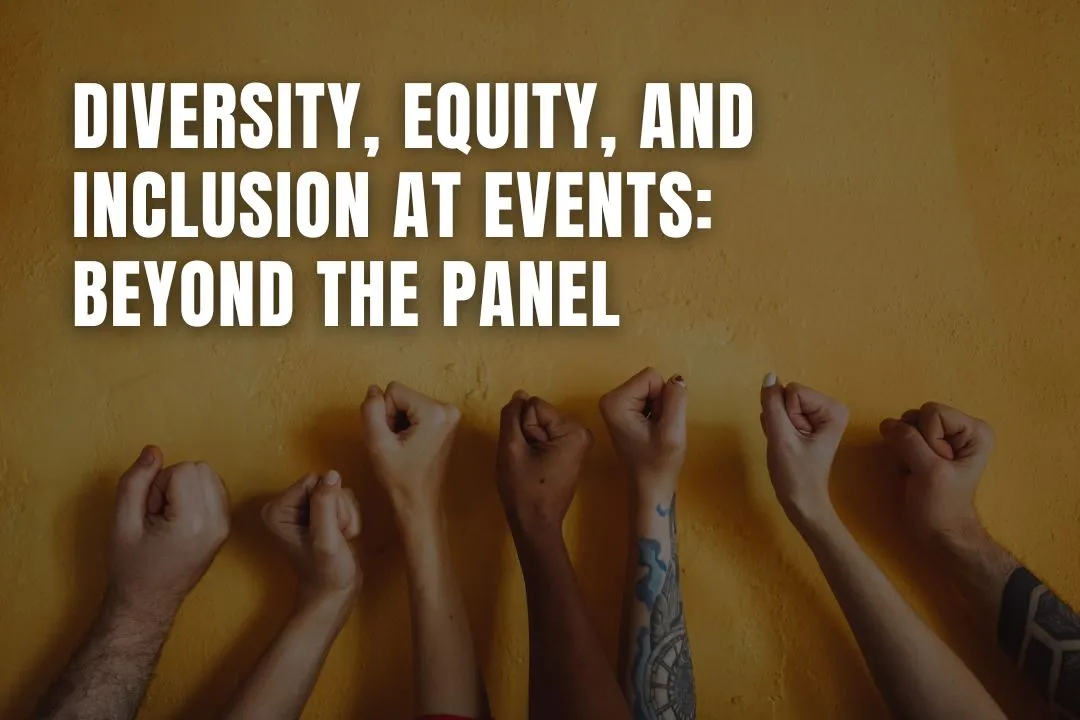
In recent years, diversity, equity, and inclusion (DEI) have become essential pillars of event strategy, not just buzzwords. Yet too often, organizations equate DEI with simply hosting a panel on representation or booking a few diverse speakers. While those are positive steps, they barely scratch the surface.
Real DEI at events is not a box to check; it’s a mindset that must permeate every aspect of event planning, from speaker curation and attendee outreach to accessibility, vendor selection, and post-event impact. It’s about creating truly inclusive environment, whether in-person, virtual, or hybrid, where every participant feels seen, heard, and valued.
Here are actionable ways to move beyond performative gestures and build DEI into the DNA of your events.
Too often, event organizers choose from the same pool of “go-to” speakers, which can lead to homogenous panels. Instead, make a conscious effort to diversify your speaker roster across race, gender, ability, geography, and industry experience. Go beyond just inviting diverse voices, give them the keynote slot, the fireside chat, the panel moderation role. Representation isn’t just about presence, it’s about power and visibility.
Tip: Partner with networks and databases that focus on underrepresented professionals, such as Women in Tech, Diverse Speakers Bureau, or Black Speakers Network.
From the imagery in your ads to the language in your email invites, your marketing should reflect the inclusivity you’re aiming to foster. Ask: Does our content speak to a wide range of attendees, or does it cater to a narrow demographic?
Use inclusive language, showcase diverse visuals, and avoid jargon or assumptions about background, education, or income. This not only attracts a broader audience but sets the tone before the event even begins.
True inclusion includes people with disabilities and neurodivergent individuals, who are often excluded by default due to lack of planning. Accessibility should be woven into both the physical and digital aspects of your event. This includes:
It’s also important to clearly communicate accessibility features in all event promotions and materials, people can’t take advantage of what they don’t know exists.
Every choice you make behind the scenes matters. Are your caterers minority- or women-owned businesses? Is your AV company committed to hiring a diverse crew? These decisions speak volumes.
Create a vendor selection policy that prioritizes equity and supplier diversity. It’s not just about optics, it’s about reinvesting in communities and modeling inclusive economic practices.
Inclusion must start at the table where decisions are made. Form planning committees that include people from a variety of backgrounds, roles, and lived experiences. This brings new perspectives and helps avoid blind spots when designing sessions, venues, and engagement activities.
A diverse team is more likely to catch unintended exclusions, identify better ways to reach marginalized groups, and bring fresh ideas that make your event stand out.
Rather than limiting DEI to one “diversity panel,” integrate it into the broader agenda. Invite speakers to address inclusion in leadership, product design, hiring, tech ethics, and community-building, depending on your event’s focus.
Also, offer sessions on identity, bias, mental health, and allyship, not as one-offs, but as consistent programming. This helps normalize these conversations as part of everyday professional development.
Traditional networking can be intimidating or unwelcoming for many. To make it more equitable:
Hybrid or virtual events? Utilize chat channels, breakout rooms, or interest-based forums to ensure everyone can participate, regardless of physical presence or social confidence.
Event tech plays a massive role in shaping experiences, especially for hybrid and virtual audiences. A good Event Management System (EMS) can help manage diverse content, track inclusive outreach, and support accessible engagement features.
In fact, 79% of event professionals use an Event Management System (EMS) to streamline planning, showing how critical the right tech is to successful event execution. Choose an EMS that allows for multi-language support, custom content tracks, and real-time accessibility features.
You can’t improve what you don’t measure. After the event, gather demographic and qualitative feedback, anonymously, on whether attendees felt welcomed, represented, and respected.
Track data on speaker diversity, accessibility usage, vendor demographics, and session feedback. Then, publish your findings (even the challenges) and outline how you plan to improve. This builds trust and transparency with your audience.
True inclusion doesn’t start and end with a single event. Extend your DEI efforts year-round through:
Events are just one chapter in your organization’s DEI story. Make sure it aligns with a broader, long-term vision for equity and impact.
Diversity, equity, and inclusion are no longer optional, they are essential to creating meaningful, modern events that resonate with today’s audiences. And while hosting a DEI panel is a start, the real work lies in embedding inclusion into every layer of planning and execution.
From the language you use to the tech you choose, and the people you empower, every decision is an opportunity to include or exclude. Let’s choose inclusion. Let’s go beyond the panel.